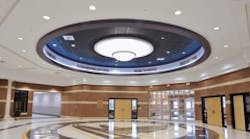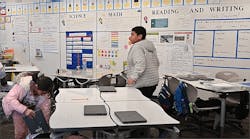Many people in a community think of education only in the context of learning. But whether a school is public or private, coed or single-sex, urban or rural, affluent or struggling, education is a business. The business isn’t necessarily focused on profitability like the corporate sector, but large operating and capital budgets are needed for salaries, equipment, improved technology, programs and building operations. Costs for these variables will continue to rise, so school officials must control what costs they can.
Cost savings begin by building wisely. One option to consider is a metal building system. Architects have uttered phrases similar to this to many school officials and communities, and some architects have been laughed at because of negative notions about metal buildings. Many think metal building systems are what Farmer Tom should add to his property to control costs, not what a school system needs.
Misconceptions and Reality
If education institutions look past some of the misconceptions about metal building systems, they might find a solution for the next school project:
•Misconception: Metal buildings aren’t customizable. The base of a metal building system is a high-performance, flexible structural steel frame. This frame bears the load of a building, so the exterior finish actually is customizable with a variety of materials. Aesthetics and local codes can dictate the selection of wood, glass, brick, masonry, exterior insulated finishing system (EIFS) or factory-insulated panels.
•Misconception: Conventional building is more economical. Metal buildings systems may be less expensive because they can be purchased from a single-source supplier. A metal building from a single source may offer faster, consistent and more efficient construction and lower life-cycle costs than traditional construction. In addition, savings are possible because metal buildings can be erected year-round without typical weather delays—and generally can be built in one-third the time of conventional construction. Weather doesn’t affect the ability to join the building system elements; metal buildings are fabricated in a plant for bolt-type construction at the site.
•Misconception: The look is a square, fixed, tin box. Computerized customization of materials enables a design to express the learning vision of each specific school. The inside of the building is equally customizable because metal building systems can be expanded easily. Clear spans make possible large spaces such as pools, gyms, atrium spaces and auditoriums. Education institutions can add or reconfigure large assembly areas as needs and campus populations change.
•Misconception: Metal buildings are flimsy, drafty, non-energy-efficient structures. Many elements are available that can improve the strength and sustainability of metal buildings. Steel framing is a sustainable material with recycled content and recyclability at the end of its useful life. Because of this, it can receive LEED points and accreditation from other sustainability programs. The strength of steel also adds stability, fire resistance and a longer life to a building. If factory-insulated wall panels are chosen, they add energy-efficiency with their predetermined insulation R-values. A standard range is R-16 to R-32, so schools and universities have options to meet their specific needs.
An additional touch of sustainability can come via electricity cost savings realized through the use of skylights, clerestory windows and other natural light alternatives. These daylighting strategies help keep light fixtures turned off. Metal roofing is an additional upgrade option. Because of coating technology, cool metal roofs reduce the urban heat-island effect, have increased solar reflectivity and decrease energy consumption. Many metal roofs also are fire- and hail-resistant, and offer superior wind-uplift performance.
•Misconception: Metal buildings cannot meet code. Metal buildings, like all other structures, must meet applicable codes and often they significantly exceed building code requirements when coupled with options for improved energy efficiency.
•Misconception: Metal buildings are not a viable option for solar panels. Metal buildings have the strength and flexibility to support solar roofing panels. On a metal roof, particularly standing-seam configurations, solar panels can be clipped to the seams without roofing perforations. An additional advantage of a metal roof is that solar systems last longer. Studies indicate that metal roofing can last 50 years or longer compared with 20 years for traditional roof systems (according to a Ducker research study). A recent advancement in metal roofing technology is building integrated photovoltaic systems (BIPV). Some manufacturers offer BIPV solar systems laminated onto the metal panel.
Sidebar: Proving It
The Louis and Josephine Buondonno Forum at St. Augustine Preparatory School in Richland, N.J., was a fast-track, design-build project completed in 14 months. The architect was asked to design the 96,000-square-foot addition to complement two existing buildings. This addition provided science labs, academic classrooms, athletic facilities, a dining hall, chapel and administrative offices. To accomplish this, a metal building system was selected. For the pool, dining hall and gymnasium, the structural system provided column-free clear spans. A brick exterior was selected to match the existing buildings.
A metal roof added an aspect of sustainability sought by the school. Solar panels were added to the metal roof to supply about 60 percent of the building’s electricity.
"You have to do your homework, but the beauty is in the simplicity and feasibility of the structural system," says Larry Merighi, AIA, partner with Manders Merighi Portadin Farrell Architects. "Most people walk in and say, ‘We didn’t know this was a [metal] building.’ That’s really neat."
Praeger is the assistant general manager of the Metal Building Manufacturers Association, Cleveland, and past chairman of the Cool Metal Roofing Coalition. He can be reached at [email protected].



